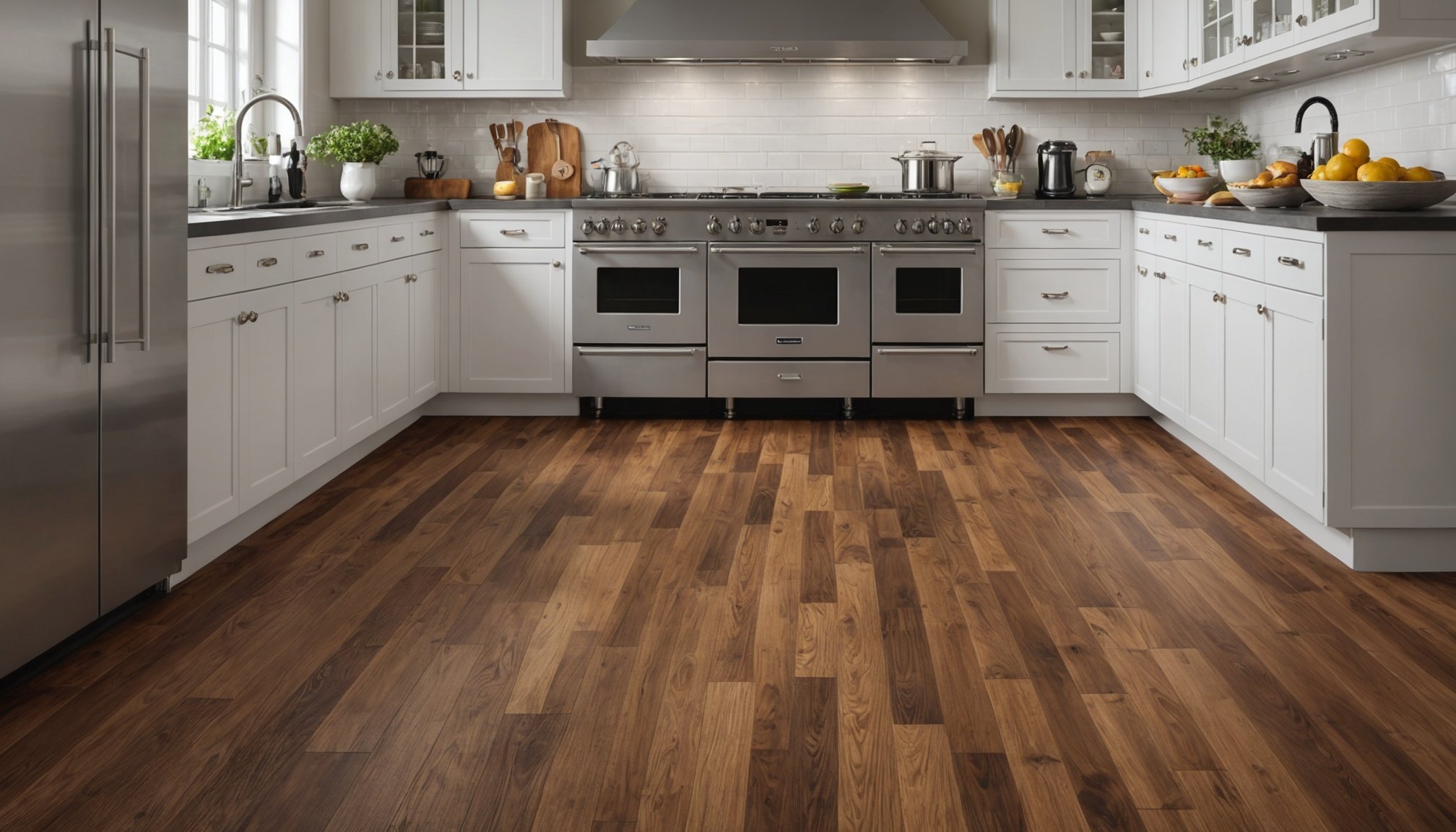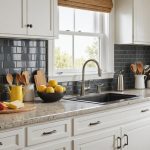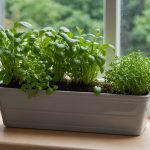Overview of Anti-Fatigue Flooring Solutions
Anti-fatigue flooring is crucial in kitchens, particularly for those who spend long hours cooking or standing. These flooring solutions are designed to reduce physical stress and fatigue by providing cushioning and support, contributing to overall kitchen comfort. The incorporation of such flooring in a small kitchen can vastly enhance comfort levels without compromising space.
Various materials are suitable for anti-fatigue applications, each offering unique benefits. Common types include foam, rubber, and cork, each contributing differently to the reduction of foot pain and physical fatigue. Foam flooring, for example, is lightweight and provides excellent insulation, making it a good option for smaller spaces. Rubber offers durability and is resistant to heat and moisture, making it ideal for kitchen environments. Cork provides a sustainable choice, known for its cushioning properties and noise reduction capabilities.
Also to discover : Discover the ideal slow cooker for creating flavorful low-calorie soups and stews!
Choosing the right flooring is integral to achieving a comfortable and functional kitchen space. The flooring type has a direct relationship with overall kitchen comfort, impacting how enjoyable and productive the environment can be for daily activities. These solutions not only enhance the aesthetic but also support physical well-being.
Types of Anti-Fatigue Flooring
Anti-fatigue materials in kitchen flooring provide vital support during long standing periods. Considering different flooring types helps in choosing the most suitable for your kitchen’s needs.
This might interest you : Ultimate guide to kitchen wall insulation: boost comfort and minimize cooking time
Foam Flooring
Foam flooring offers exceptional comfort due to its cushioning. Its insulation properties make it perfect for small kitchens, ensuring a warm and inviting atmosphere. Furthermore, foam is lightweight, aiding in quick installation without professional help. However, regular vacuuming and gentle cleaning with non-abrasive products maintain its softness and durability.
Rubber Flooring
Rubber flooring stands out for its robust durability, making it excellent for kitchens where spills are frequent. Its heat and moisture resistance safeguards against kitchen hazards while being low-maintenance. Rubber comes in various colors, allowing homeowners to personalize their kitchen space with suitable aesthetic choices.
Cork Flooring
Renowned for being eco-friendly, cork flooring provides a sustainable alternative. Its natural cushioning alleviates joint stress, and its inherent noise reduction feature suits compact spaces. Proper maintenance ensures longevity; sealing cork flooring periodically protects it from potential damage, maintaining its appearance over time.
Selecting the appropriate anti-fatigue flooring requires understanding each material’s advantages, aiding in creating a comfortable, efficient kitchen.
Installation Tips and Considerations
Choosing the right flooring installation process for your kitchen can be as crucial as the material itself. Whether you aim for a DIY approach or seek professional assistance, understanding the requirements for each flooring type is essential.
For a DIY flooring project, foam flooring is an excellent option. Its lightweight nature simplifies handling and ensures a quick installation process, requiring only basic tools like a utility knife and adhesive tape. Regularly clean with non-abrasive products to sustain durability.
Rubber flooring, known for its robustness, might require professional installation, especially in larger spaces which can present challenges, such as cutting and fitting. However, small kitchen floors can be managed with a little DIY skill, keeping in mind to allow expansion space for thermal changes.
Cork flooring also offers a manageable DIY option with its tongue-and-groove planks. Ensuring a leveled substrate is pivotal for smooth installation. Sealing cork is necessary post-installation to protect from moisture.
When to consider professional installation? If your kitchen flooring project involves intricate designs or expansive areas, professional help ensures perfection and saves time, safeguarding your flooring investment.
Pros and Cons of Each Flooring Solution
When choosing kitchen flooring, understanding the pros and cons of each solution is essential for making informed decisions. Anti-fatigue flooring addresses comfort, but varied materials offer distinct advantages and challenges.
Foam Flooring: Highly praised for its cushioning, foam enhances comfort during prolonged standing. It insulates well, ideal for chilly kitchen environments. However, its softness can lead to wear over time, necessitating regular replacement.
Rubber Flooring: Known for durability, rubber withstands heavy foot traffic and kitchen spills. Its resilience offers a long-term investment, although installation can be costly, especially for extensive areas. Yet, in smaller kitchens, rubber’s moisture resistance is invaluable.
Cork Flooring: Eco-conscious homeowners often opt for cork due to its sustainability. It provides excellent shock absorption, reducing joint strain. Despite these benefits, cork’s vulnerability to water damage means frequent sealing. The investment balances eco-friendliness with maintenance demands.
Each material’s suitability varies by kitchen style and use, with foam favoring gentle environments, rubber excelling under pressure, and cork appealing to those prioritizing ecological impact. Consider how these factors influence both your kitchen’s functionality and comfort.
Overview of Anti-Fatigue Flooring Solutions
In kitchens, anti-fatigue flooring plays a pivotal role in enhancing comfort for those standing for extended periods. By utilizing innovative flooring solutions, these options aim to reduce physical stress and fatigue, fostering a more ergonomic environment. Especially in small kitchens, the implementation of such flooring can significantly boost comfort without sacrificing precious space.
Different materials are tailored to suit anti-fatigue needs, each presenting distinct advantages. Key kitchen comfort materials include foam, rubber, and cork. Foam flooring offers excellent insulation and is lightweight, making it favorable for compact areas. Meanwhile, rubber brings durability and resistance to kitchen challenges like heat and moisture, ensuring longevity. On the sustainability front, cork presents itself as an eco-friendly choice with its natural cushioning and noise-dampening abilities.
Selecting the appropriate flooring type directly correlates with overall kitchen comfort. It’s instrumental in shaping how both pleasant and efficient your kitchen workspace becomes, enhancing not only functionality but also the user’s physical well-being. These thoughtful flooring solutions not only enrich the design but also prioritize your health in the culinary setting.
User Reviews and Real-Life Experiences
User experiences are invaluable when considering the most suitable flooring solutions for your kitchen. Real-life feedback highlights the practical aspects of each option, offering insights into both strengths and potential pitfalls.
Homeowners frequently praise anti-fatigue flooring for transforming kitchen usage, with many noting the marked improvement in kitchen comfort. Users of foam flooring appreciate its soft cushioning, which reduces strain during long periods of standing. However, some mention the susceptibility of foam to wear, advising consistent cleaning to prolong its life.
Reviews of rubber flooring often focus on its robust durability and ease of maintenance. Many users find its heat and moisture resistance crucial, although a few express concerns over a sometimes limited range of color options, suggesting a richer palette could enhance its appeal.
Those who have opted for cork flooring often commend its eco-friendliness, citing its thermal insulation and soundproofing as standout features. Yet, water vulnerability is a recurring comment, leading users to recommend regular sealing to mitigate damage.
Drawing from customer feedback, successful installation and maintenance are essential for sustained satisfaction, underscoring the importance of informed decision-making to ensure long-term enjoyment.
Maintenance Best Practices
Proper flooring maintenance is essential to maximise the longevity of flooring and preserve its appearance over time. Regular care prevents unnecessary damage and extends the life of your investment.
For foam flooring, weekly vacuuming is vital to remove dirt that can degrade the material. Use non-abrasive, gentle cleaners to maintain its softness and elasticity. Avoid harsh chemicals that may cause discoloration or weakening, particularly important in high-traffic kitchen areas.
Rubber flooring requires simple upkeep. Sweep or vacuum frequently to prevent debris build-up. Mop with mild detergent occasionally, ensuring no water is left on the surface to future-proof seal integrity. Its robust nature means minor scuffs can usually be buffed out with little effort, enhancing its durability.
For cork flooring, a natural composition necessitates regular sealing. This practice safeguards against moisture damage. Use a damp mop for cleaning, avoiding excessive water which could compromise its structure. Applying a protective sealant every few years is advisable to maintain its eco-friendly properties and cushioning effect.
By adhering to these care tips, your kitchen flooring can sustain its structural and aesthetic qualities, assuring both its functionality and style endure throughout its lifecycle.











